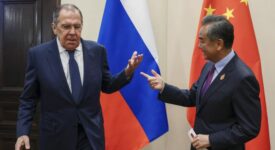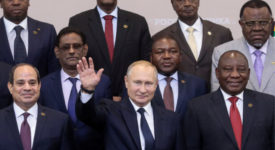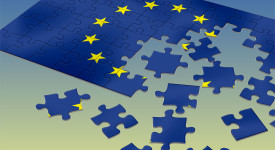The EU’s Eastern Partnership (EaP) is divided into those countries that signed Association Agreements with Brussels and those preferring to stay closer to Eurasian integration. Bringing the two groups closer together is not politically impossible.
Analysts generally see five scenarios that could help frame the future of EaP countries’ relations with the EU and Russia: 1) the status quo in which both sides will try to weaken the position of the other; 2) trilateralism (EU, Russia plus an EaP country), which has failed in the past, but still is considered as a possibility by some policy analysts; 3) the Kazakhstan-Armenia model of diplomatic progress towards the EU, with some likely leverage on Russia; 4) more engagement by the EU with the Eurasian Economic Union, which has a say on tariffs and technical standards; and 5) the decoupling of security policies from economic development, which is so far the most challenging option to foresee and implement in practice.
The maintenance of a status quo is guided by the idea that Russia intrinsically thinks that any EU presence in the post-Soviet space is contradictory to Russian interests and is anti-Russian. Despite the obvious potential for economic cooperation, it is very unlikely to see any of it in the post-Soviet space. Russia is therefore very likely to continue its destabilization policies by supporting non-mainstream political parties throughout the bloc.
Trilaterism would be a comeback of a former model in which the EU would lead the process and Russia would be woven in. While a few leaders across the post-Soviet space support this option, so far all attempts have failed. Russia generally stays in touch with the EU over the coordination of its policies in Eastern Europe, though this cooperation has obvious limitations. There are, however, hopes that both sides will be able to continue their dialogue on the Balkans in the context of EU enlargements. Despite this rather dire outlook, there is still potential for cooperation such as in technical regulations, as recently demonstrated in Moldova.
The Kazakhstan-Armenia model of diplomatic progress towards the EU is based on Association Agreements that are consistent with the former’s commitments to the Eurasian Economic Union. Following Yerevan’s example, Moldova has started talking about a new way of relations with Brussels. The 2017 Armenia-EU agreement was hailed as a compromise suitable to all three capitals – Yerevan, Brussels and Moscow.
Option 4 is about more engagement between the EU and the Eurasian Economic Union. This would, however, require de-politicization of a number of European relations including removing the political agenda from the settlement to the conflict in Crimea. This option has many supporters in Europe since quite a few observers claim that Europe might have been too aggressive in its outreach programs in the post-Soviet space.
The last option – the decoupling of security strategy from economic interests – is the most challenging one. It means that both sides would refrain from establishing control of specific territories and try to find more innovative non-territorial forms of influence. This would also imply the need for a functional division of areas of interest and responsibility. Importantly, this scenario is unrealistic unless both sides make a mutual adjustment in economic and security spheres.
‘Incomplete Hegemonies, Hybrid Neighbors: Identity Games and Policy Tools in Eastern Partnership Countries’ – Working Paper by Andrey Makarychev – Center for European Policy Studies / CEPS.
(The Working Paper can be downloaded here:
https://www.ceps.eu/publications/incomplete-hegemonies-hybrid-neighbours-identity-games-and-policy-tools-eastern)







